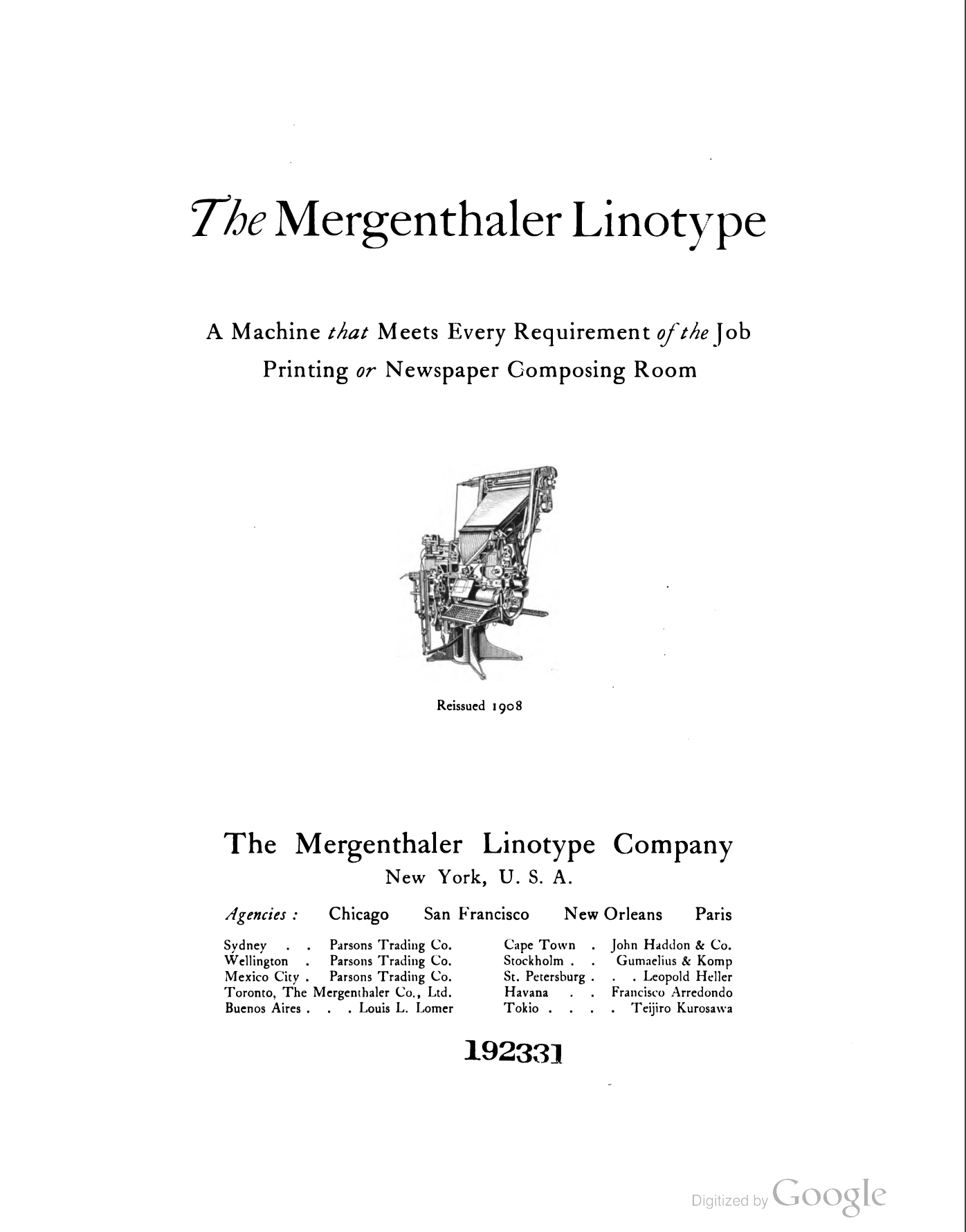Text reproduced with permission from David MacMillan.
In doing text searches to research the origins of the name 'Simplex Linotype,' one does come across a use of 'simplex' in conjunction with 'Linotype' which is entirely unrelated to the naming of any machine. It's a use (and concept) which is a bit alien to the way the final few generations of Linotype operators and machinists were used to thinking about the machine, so it requires some clarification.
The magazines of the early Linotypes (up to the Model 4) were difficult to remove. The Mergenthaler company itself admitted that it took three to five minutes to change a magazine for the Models 1, 2 and 3, and two minutes for the Model 4. While shops did "keep on hand a number of magazines containing matrices of various faces ... to change one magazine for another as occasion may require" (ML, 1908) this was not the easy process it later became. It was not common then to have racks of magazines loaded up with particular matrix fonts, ready to be swapped quickly on to a machine.
This changed with the introduction of the 'quick change' magazine of the Model 5 in 1906. In an advertising book and parts catalog issued along with the release of the Model 5 (and thus presumably dated to 1906, although the copy here is the 1908 reprint), the Mergenthaler Linotype Company made much of this capability.

Here are two images from this booklet showing the ease with which magazines could be change. On the left is the Model 5, with a single magazine which could be changed in sixty seconds from the front of the machine. On the right is the Model 4, a two-magazine mixer. The top magazine was changed from the front of the machine, while the bottom magazine was changed from the back. You could even change the bottom magazine while assembling lines from the top. (I don't suppose you'd want to send, cast, and distribute a line with mats from the lower magazine while this was happening, though!)


For the first time, it made sense for a shop to buy many magazines and keep matrix fonts in them. Mergenthaler was happy to accomodate this by providing suitable equipment.
Say, for example, that you had a Model 5, which was a machine capable of mounting a single magazine at a time. If you purchased this machine with 'simplex fittings,' you'd get just one magazine. Since you'd have to run new mats into the magazine to change faces, they supplied only one set of mold liners and one ejector blade. (In the early machines, to change line length you had to manually change ejector blades. I've seen an experienced operator do this, and it can be done surprisingly quickly if you know what you are about.) The Model 5 mold disk had (then) two pockets for molds, but you only needed to buy a mold for one of them (you would run a blank mold, for balance, in the other). In 1908, this would cost $500, cash.
If on the other hand you desired 'duplex fittings,' you got a second magazine, another matrix font, and another set of mold liners (presumably your second matrix font might be a different body size, and thus require different mold liners). You could buy a second mold and set things up so that you could use one mold with your first magazine and the other with your second. (They gloss over the fact that if the molds were set up for different line lengths you'd have to do an ejector blade change each time you switched.) This ran $575, cash.
'Triplex equipment' would set you back $650.
They would also sell duplex and triplex fittings for the other models available at the time: the older Models 1, 2, 3, and 4, the Model 7 (a wide-measure Model 4) and the Model 6 (a wide-measure Model 5, and thus a "quick change" machine).
(It is also interesting to note that they would only sell the Linotype to 'responsible persons.' This is still a wise practice.)
Here is an extract, in PDF form, of the three pages from The Mergenthaler Linotype (1908) which discuss simplex, duplex, and triplex equipments/fittings for the Linotype.

This text was originally a part of the article "The 'simplex' Linotype - never made in America" and was originally published at https://www.circuitousroot.com/artifice/letters/press/compline/technology/models/linotype-us/simplex/index.html#afb-38-7-282 and is republished here with permission from David MacMillan.
C 2021-2024 Maarten Renckens and other contributors. All rights reserved. All materials on this website are available for non-commercial re-use, as long as the original author is mentioned and a correct reference to this site is added. Thanks!
All materials are considered copyrighted by the author(s) unless otherwise stated. Some materials from other sources are used. If you find materials on this page which you consider not free from copyright, a notification is appreciated.
All collaborations and additional sources are more than welcome. Please contact info@maartenrenckens.com if you have materials that you deem valuable.